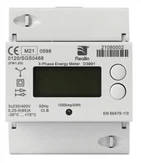With the rapid development of electronic technology, the performance evaluation and energy efficiency management of various electronic devices are becoming increasingly important. As an indispensable measuring instrument in the electronic field, the power meter plays a key role in this process. It can accurately measure the power parameters of electronic equipment or circuits, and provide important data support for electronic research and development, production, testing and other links.
Content:
1. Basic definition of power meter
2. Core function of power meter
3. Main types of power meters
3.1 Traditional power meters
3.2 Digital power meters
3.3 RF power meters
4. Application of power meter
5. Summary
1. Basic definition of power meter
The power meter in the electronic field is an instrument specifically used to measure electric power. Electric power refers to the electric energy consumed or output by a circuit per unit time, and the unit is watt. It can not only measure active power, but also measure related parameters such as reactive power, apparent power and power factor, reflecting the power characteristics of the circuit in all directions.
2. Core function of power meter
The core function of the power meter is to capture and measure the power changes in the circuit in real time and accurately.
It synchronously samples the voltage and current of the circuit under test through internal sensors and measurement circuits. During the measurement process, the voltage sensor detects the voltage signal at both ends of the circuit, and the current sensor detects the current signal flowing through the circuit. These two signals are sent to the power calculation unit after amplification, filtering and other processing.
3. Main types of power meters
3.1 Traditional power meters
Traditional power meters usually use analog circuits for signal processing and power calculation. They have a relatively simple structure and low cost. They are suitable for conventional circuit power measurement that does not require high measurement accuracy, such as power detection of household appliances.
3.2 Digital power meters
Digital power meters use digital signal processing technology to digitize and calculate the sampled voltage and current signals. They have the characteristics of high measurement accuracy, fast response speed, and rich functions. It can accurately measure the power of complex waveforms such as high-frequency signals and pulse signals, and is widely used in high-precision measurement scenarios such as communication equipment and aerospace electronic equipment.
3.3 RF power meters
RF power meters are specifically used to measure the power of RF signals. RF signals have high frequencies, usually in the range of hundreds of kilohertz to tens of gigahertz. It uses special sensors (such as thermocouple sensors, diode sensors, etc.) to detect RF power, and plays an important role in RF technology fields such as wireless communications, radars, and satellites.
4. Application of power meter
Power meters are widely used in the electronics field, running through the entire chain of the electronics industry, including R&D, production, and quality inspection.
In the R&D stage, engineers use power meters to test the power consumption of newly designed circuits, optimize circuit structures, and improve the energy efficiency of equipment; in the production process, power meters are used to calibrate the power of electronic equipment and conduct factory inspections to ensure that the products meet power standards; in the quality inspection link, power meters can conduct regular power inspections on electronic equipment put into use to determine whether the equipment is operating normally, detect power abnormalities in a timely manner, and ensure the safe and stable operation of the equipment.
5. Summary
As a key instrument for measuring power in the electronics field, the power meter's precise measurement capabilities provide a solid foundation for the development of electronic technology and the quality assurance of electronic equipment, and play an irreplaceable role in promoting the development of the electronics industry towards high efficiency, energy saving, and precision.




